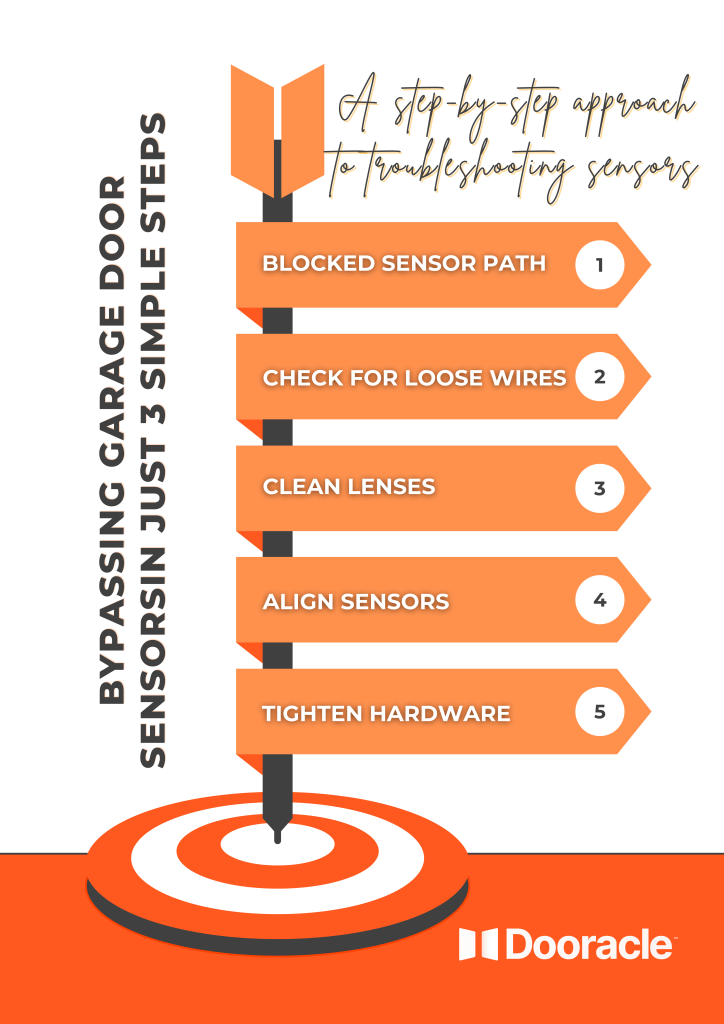
Introduction
One of the parts that always comes with your garage door opener is the sensors. They are there to halt your door’s movement whenever they detect something that hinders the door from closing fully. While it is an excellent feature to prevent any accidents, it is one mean and irritating safety feature when the garage door sensors do not operate well. Therefore, the following is a comprehensive guide with various troubleshooting methods to maneuver their way into being able to bypass garage door sensors. Though, as dangerous and risky as this guide might seem, one should comprehend the risk and penalties of bypassing the sensor’s safety
features.
Specifically, do you know why you shouldn’t bypass your garage door sensors?
It is assumed by most to be counterproductive due to the sensors’ role; it plays a pivotal role in safety. These are sensors that rest at the base of your garage door to prevent the door from closing when something is obstructing it. In the end, I can confirm that it is best seen, and while there are troubleshooting options, homeowners may feel the need to eliminate the hassle altogether. However, that poses many risks. Abandoning your garage door sensors entirely would risk, not only your safety, but also your home being vulnerable to burglary as well. Additionally, it is supposedly illegal in various states, which will lead to a penalty and legal issues for you.
Do-it-Yourself: A step-by-step approach to troubleshooting door sensors
1. Blocked Sensor Path
Ensure that there are no objects in the sensor path and check the presence of direct sunlight
2. Loose Wires
Before checking the sensors for frayed or exposed wires, ensure that the garage door opener has no power. Reconnect or replace the damaged wires before reapplying power.
3. Dirty Lenses
Make sure the lenses that enable beam registration are clean. Ensure you do not misalign the sensors while cleaning them.
4. Sensors Not Aligned
Check for green and red lights on both sensors to tell if they are correctly aligned. Green lights indicate perfect alignment.
If the above procedure fails, the next step involves bypassing the sensors. However, act cautiously.
How to Bypass Your Garage Door Sensors:
A Temporary Solution

1. Propping Open Your Door:
Prop open your door and use something solid to firmly support it.
2. . Turn On Manual Mode:
Pull the release cord so that the automatic opener’s gear shifts out of the door trolley
3. Close/Open the Door Manually
From this point on, you can open and close it by hand when the latter is deactivated. When you need to return to regular use, reattach the door trolley to the opener carriage.
How to Bypass Your Garage Door Sensors:
A Temporary Solution
It should be noted that bypassing sensors permanently requires working with wires on sensors and only can be done if there is no other way.
1. Cut the Wires:
Firstly, cut the wires by disconnecting power and cut wires to leave five inches to work on. Additionally, seal end wires withelectrical tape.
2. Tape the Sensors Together
Secondly, tape the sensors together by safely taping face-to-face sensors.
3. Rewire the Sensors
Thirdly, rewire the sensors. Connect both colorcoded blocks with cut wires to the garage door opener.
4. Store the Sensors:
Finally, store the sensors. Stack sensors on top of
openers in the storage for a properly closed system

Note
Permanently disabling sensors is not recommended, except when your sensors are broken, and a replacement is out of the question. Safety first. By following these principles, you will be able to address and, if necessary, disable your garage door sensors. Finding a middle ground between convenience and safety is the only way to succeed.
